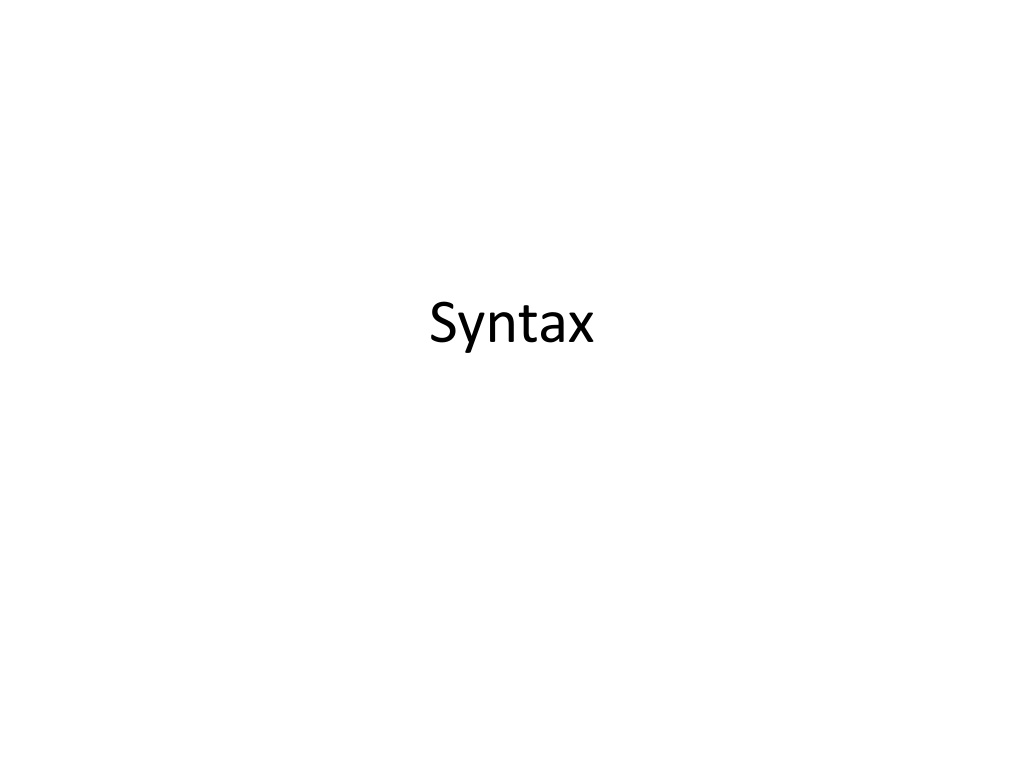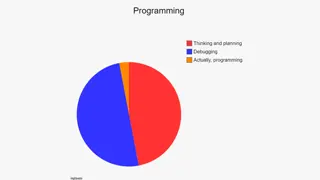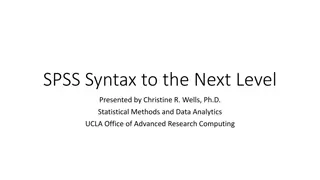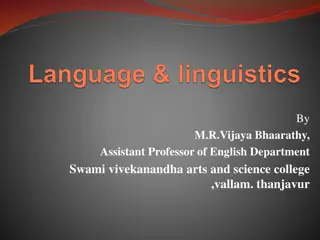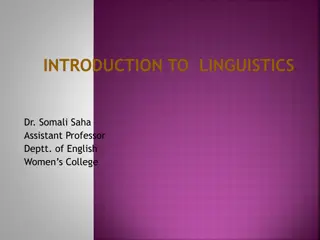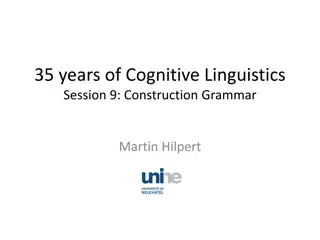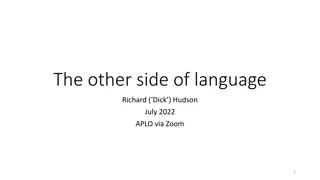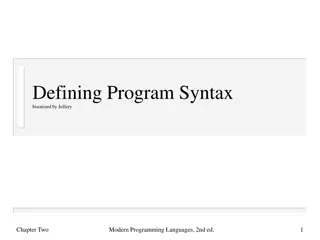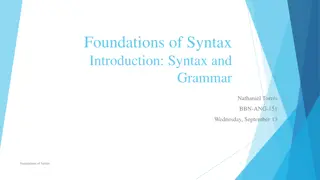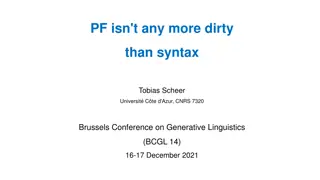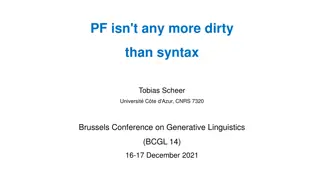Understanding Syntax in Linguistics
Words in a language are organized into phrases and clauses with specific syntactic categories like Noun Phrase, Verb Phrase, and Adjective Phrase. Each phrase has a head such as a noun, verb, or adjective, and phrase structure rules help diagram the syntactic structure. Clauses are the largest units, containing a subject and predicate, and can be independent or subordinate. Syntax involves rules for organizing words into phrases and clauses, influencing how we understand sentence structures and parts of speech.
Download Presentation

Please find below an Image/Link to download the presentation.
The content on the website is provided AS IS for your information and personal use only. It may not be sold, licensed, or shared on other websites without obtaining consent from the author. Download presentation by click this link. If you encounter any issues during the download, it is possible that the publisher has removed the file from their server.
E N D
Presentation Transcript
Syntax: Heads and Phrases Words are organized into phrases and clauses Each phrase is of a particular syntactic category (Noun Phrase, Verb Phrase, Adjective Phrase,, ect), and each has a head (noun, Verb, Adjective, etc) Phrase structure rules provide us with a way to draw, or diagram phrases and to capture certain important generalizations about how syntactic structure is organized.
Cont The largest phrase is the clause, a syntactic unit consisting of a subject and a predicate. Clauses are independent or subordinate, depending on whether they are contained in larger phrases.
Syntax System of rules and principles that describe how we organize words into phrases and phrases into larger units, the largest being the clause; also the study of this system. The position of the word in the sentence is often the only way we know its syntactic category (parts of speech). E.g: The girl goes on many long walks. The girl walks the dogs.
Cont 1. walks is a noun;it occurs to the right of long, the adjective that modifies it. 2. walks is a verb; it occurs after the subject the girl, and before the object, the dogs Syntax is that words can be grouped or combined in certain ways. E.g. Six hungry gorillas spotted the sandwiches. Six hungry gorillas spotted the sandwiches.
Cont.. Sentence is a general term for a long string of words but sentences can be made up of one or more clauses, syntactic units. e.g. The gorillas thought that they spotted the sandwiches when they were strolling through the jungle. The sentence above contains two smaller clauses.
Cont Phrase: syntactic unit (NP, VP, etc.) headed by a syntactic category (N,V,etc). Independent and dependent clause
Nouns and Noun Phrases The granflons ? Nonsense word Parts of speech? Noun because English nouns usually follow a certain set of words (in this case, the determiner, the) Quantifiers, numerals, and determiners are all functional categories (Det) * eight all dogs , all eight dogs Certain nouns need no determiner at all; generic nouns and mass nouns. E.g. Lions roar. (generic plural noun) Madawi makes lovely jewelry. (mass noun)
Cont Proper names usually occur without determiners, too. Sarah walked in the door. (proper noun) *The Sarah walked in the door. Some proper nouns do take determiners, however, The Eifel Tower is an amazing building. The New York Mets played a game yesterday.
A phrase Structure rule for noun Phrases Phrase structure a system of rules that organizes words into larger units or phrases. Descriptions and generalizations about the syntax of nouns and the categories that introduce nouns are aspects of phrase structure and can be expressed by phrase structure rules for the larger syntactic unit, the Noun Phrase, or NP.
Cont. In phrase structure rules, items in parentheses are optional. e.g. NP (D) N D these, six, all, every, the/a an NP can contain a determiner (optional) and must contain a noun. The syntactic structure is divided into phrases and each phrase must have a head.
Cont So a NP must contain at least a noun and a VP must contain at least a verb. The head of the phrase is the most important part because it determines the category of the phrase. All the elements that combine to form a phrase are called constituents. So, N is the head of NP, a phrase that can also include D. Both D and N are constituents of NP.
Cont A graphic representation of phrase structure: NP NP these mangoes four mangoes NP all mangoes
Verb and Verb Phrases Verbs in English has 5 forms: infinitive, present tense, past tense, present participle, and past participle Syntactically, verbs can be divided into three groups: auxiliary, main, and modal Main verbs: feel, go, eat, run, hope Afnan feels happy. Deema went on a trip.
Cont Ashwag ate kabsa. Obama hopes to win the election Samar ran the Marathon. Auxiliary verbs: have, be Fatimah has eaten too much candy Noura is running for his life. Modal verbs: may,might,shall, should, will, would, can, could, must Hanadi may, might, shall, should, will, would, can, could, must go on a cruise.
Cont Auxiliary, main, and modal verbs occur in a certain order in English. The following sentences illustrate the various combinations of the main verb read with auxiliary and model verbs. These combinations follow a particular syntactic pattern: Thekra should have been reading under the umbrella. Afrah should be reading under the umbrella. Faridah should read under the umbrella
Cont Latifah read under the umbrella. *Thekra have should been reading under the umbrella. *Afrah should reading be under the umbrella. *Faridah read should under the umbrella. In addition to a main verb, the VP can include as many as 3 other verbs. These options include a modal (which, if present, must come first) and as many as two auxiliary verbs, forms of have or be.
Cont Modal + have+ be+ main verb Might have been sleeping Modal+ have + main verb Might have slept Modal + be+ main verb Might be sleeping Modal + main verb might sleep
Cont Have + main verb -- has slept Have + be + main verb-- has been sleeping Be+ main verb -- is sleeping Main verb-- slept Main verbs are not optional in the sentence: (modal) (have) (be) main verb
A Phrase Structure Rule for Verb Phrases
